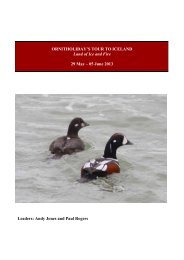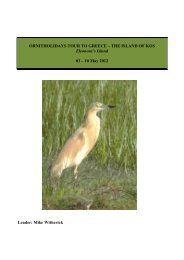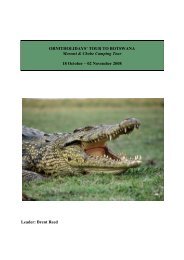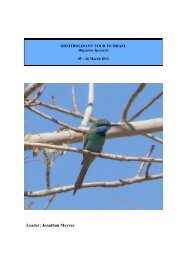Download 2014 Brochure (.pdf) - Ornitholidays
Download 2014 Brochure (.pdf) - Ornitholidays
Download 2014 Brochure (.pdf) - Ornitholidays
Create successful ePaper yourself
Turn your PDF publications into a flip-book with our unique Google optimized e-Paper software.
U S A – H A W A I I<br />
USA – Hawaii<br />
Iiwis, Omaos & Nenes<br />
Thursday 16 April – Wednesday 29 April 2015<br />
Leaders: David Kuhn and Nigel Jones<br />
2015 Cost £4,799 single room supplement £600<br />
awaii may be famous for Waikiki Beach and Pearl Harbour, but it hosts an interesting variety of endemic birds. Spring is the<br />
Hbest time for birding the Hawaiian Archipelago - the forest birds are most vocal and active, and large numbers of seabird<br />
species are present. We visit the four main Islands of the group: Hawaii, Maui, Oahu and Kauai, in a geographical progression<br />
beginning in the south-east with the oldest island, and working our way north-west, to the newest. The accommodation and<br />
transportation during our tour have been selected to optimize comfort and the efficient use of our time and, as armies and bird tours “travel on their<br />
stomachs”, to afford access to some of the best restaurants to be found, many serving Hawaii’s fabulous seafood delicacies – Ahi, Ono, Opah,<br />
Opakapaka, to name a few. While it must be said that many of our target birds are difficult to find and sometimes don’t easily give lingering looks, our<br />
goal is to obtain the best views for as many of our party as our skills, preparation and luck allow.<br />
KAUAI<br />
OAHU<br />
Honolulu<br />
MAUI<br />
HAWAII<br />
(Big Island)<br />
The single most salient biological feature in Hawaii is the degree of endemism encountered in birds and in all forms of life - a feature that follows<br />
directly from the Islands’ isolation from other landmasses. The best known example is that some 20 million years ago the first North American finches<br />
arrived to find an abundance of vacant ecologic niches and the absence of competition, and through the process of adaptive radiation evolved as<br />
many as 75 species of the group known as Drepanids, or Hawaiian Honeycreepers - the brilliant jewels of the native forests. Some 20 of these species<br />
remain. Each island is home to a unique cohort of “Dreps” as well as other native forest bird species, and we can focus on these throughout the<br />
Islands. Along our way we can expect to encounter many of the non-native species introduced in the Islands. Other salient natural features on our<br />
tour include the active Kilauea Volcano, splendid native forests unique to each island, tropical palm-lined beaches, lava flows, and much, much water,<br />
from thundering waterfalls to the surrounding great wilderness of the Pacific Ocean.<br />
Throughout the tour Nigel will have the expert guidance of David Kuhn, Hawaii’s most experienced bird guide. There is the option of extending your<br />
holiday at either end of the tour by staying in Honolulu for extra nights.<br />
ITINERARY<br />
Days 1 to 4<br />
We leave London on a morning flight bound for<br />
Los Angeles, which connects with an onward flight<br />
to Hilo, where we arrive later the same day. On our<br />
descent into Hilo, we may see the peaks of Mauna<br />
Kea and Mauna Loa, Hawaii’s highest mountains.<br />
Hilo is on the east side of the island of Hawaii,<br />
(always known as the Big Island). We meet our<br />
leader, David Kuhn, and transfer to our hotel for a<br />
four night stay. From our base in Hilo we venture<br />
out to windward Mauna Kea and the splendid<br />
Hakalau National Wildlife Refuge, the first U.S.<br />
Refuge created especially for forest birds. Our<br />
target species here are the very scarce Io (Hawaiian<br />
Hawk), Omao (Hawaiian Thrush), Akiapolaau,<br />
Hawaii Creeper, Hawaii Amakihi and the Akepa.<br />
During our time on Big Island we visit Puu Laau<br />
leeward of Mauna Kea, which is a drier forest<br />
ecosystem where we look for Palila, the last<br />
remaining finch-billed Drepanid. Another area we<br />
visit is the kipukas, which are pockets of forest<br />
surrounded by fairly recent lava flows. These are<br />
found on the slopes of Mauna Kea along the<br />
Saddle Road and support a variety of endemic<br />
Hawaiian birds, such as several species of<br />
Hawaiian honeycreepers and Hawaiian Elepaio (a<br />
monarch flycatcher). The two most conspicuous<br />
honeycreepers are the impressive Iiwi and the<br />
Apapane, both scarlet all over. One day we visit the<br />
Hawaii Volcanoes National Park, where a good<br />
network of roads gives us the opportunity to<br />
explore the natural wonders of the park, including<br />
the scenic Crater Rim Drive, an 11-mile road that<br />
Nene<br />
20<br />
For a previous tour report or further information please call: 01794 519445








